Cambodia Temple #4: Bayon Temple
Established around 1190 AD by King Jayavarman VII, Bayon is a Buddhist temple yet it joins components of Hindu cosmology. Angkor Thom was established as a square, the sides of which run precisely north to south and east to west. Standing in the exact center of the walled city, Bayon temple represents the intersection of paradise and earth.
Bayon temple situated at the physical focal point of Angkor Thom, the nine square kilometer or (three and a half square) mile city complex, and is the point of convergence of the building boom King Jayavarman VII started after he vanquished the Chams to recover the Khmer Empire.
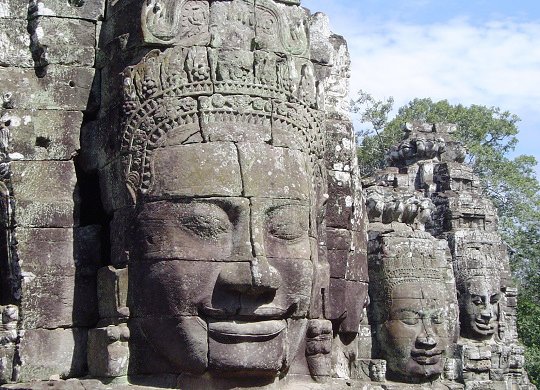
Bayon temple is known for its colossal stone faces of the bodhisattva Avalokiteshvara, with one facing outward and keeping watch at each compass point. Since this temple sits in the focal point of Angkor Thom, his state capital, this landmark makes the whole capital a temple complex, with the walls of the city and the moat representing the external mountain ranges and seas of the legendary Hindu universe. The curious smiling picture, thought by many to be a portrait of Jayavarman himself, has been named by some the "Mona Lisa of Southeast Asia." There are 51 smaller towers encompassing Bayon, each with four faces of its own. Bayon temple is encompassed by two long walls bearing a phenomenal accumulation of bas-relief scenes of amazing and historical occasions. On the whole, there are aggregate of more than 11,000 carved figures over 1.2 kilometer of wall.
In many ways the connection amongst Hinduism and Buddhism is seen here. Similarly as the Victory Gate was a piece of a three- dimensional representation of the Churning of the Sea of Milk, with Phinemeakas as the central churning stick, the Bayon is a similar representation with the gates at the four cardinal purposes of Angkor Thom. The naga (big snake) balustrade of one side of a gate that emblematically extends to the Bayon, wraps around the temple, and afterward carry on to the opposite gate, where the opposing force holds the other side of the snake.
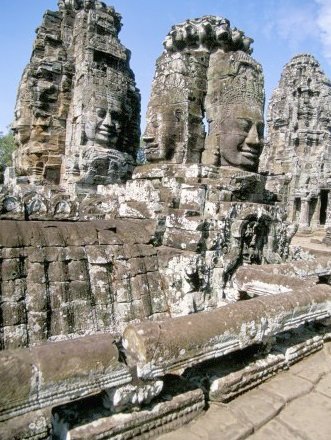
The Bayon sits in the middle as another figurative Mt. Meru. This setup likewise makes the Bayon look somewhat changed, since its outer walls are so far expelled as to seem nonexistent. From the outside, this gives the Bayon an open feel, yet the inside of the temple is quite confined.
The temple is arranged on three levels; however the particular arrangement has persuaded the researcher to trust that the first arrangement was a flat temple along the lines of Ta Prohm, which is situated toward the east.
External Gallery
While the bas-reliefs of the Hindu temples frequently manage the gods and their epic adventures, those in the external gallery of the Bayon deal more with historical occasions and regular daily life.
Some reason behind this adjustment in focus might be the differing perspectives of the Hindu and Buddhist religions. The Hindu religion puts much emphasis on issues of vast significance like the clash of gods maintain good and evil. The Buddhist religion stresses that enlightenment is achievable by the activities of the person.
For a case of a Buddhist bas- relief, investigate the bas-reliefs of the southern gallery. Some of its features are the bas- relief that describes fights with the opponent Cham Empire and additionally ordinary market scenes, fisherman, and even a cockfight.
The inner galleries basically portray Hindu mythology again. These were included by Jayavarman VIII, a successor who reestablished Hinduism as the state religion of the Hindu Khmer Empire. He transformed the Bayon to a Hindu temple, and these bas-reliefs were added later to mirror this change.
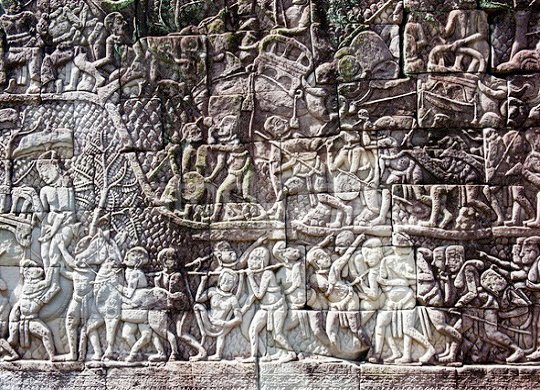
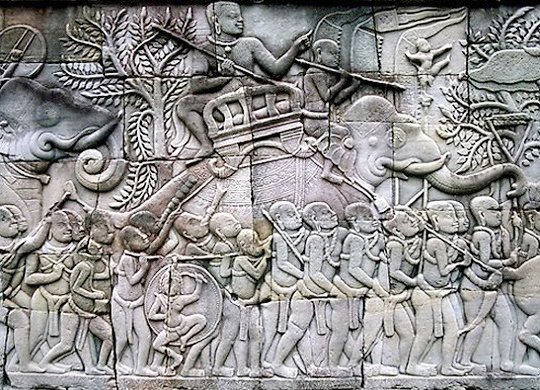
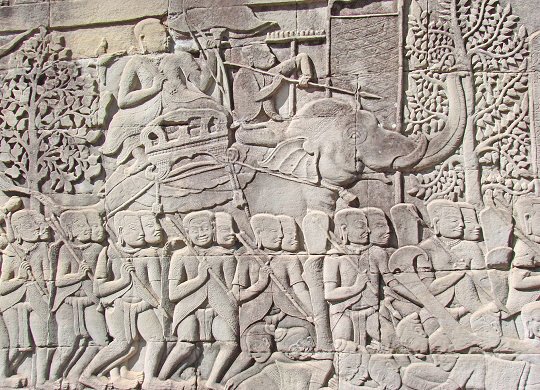
Some of these pictures are vague beyond their link with specific gods like Shiva and Vishnu, obviously great stories like the Churning of the Sea of Milk show up, as well. In addition to adding the more strictly Hindu imagery, Jayavarman VIII took the main statue from the focal tower's temple, a 3.6 meter (or 12 foot) tall Buddha, and crushed it, throwing the pieces down a well. The statue was recouped and pieced back together again in 1933. It now sits in a small pavilion on the road from the Victory Gate to the Elephant Terrace toward the northeast of here.
The Four Faces
The genuine draw of this temple, however, is the best level. As in the other temples, the stairs lead up from each of the four cardinal points to the top level, where more than four dozen towers hold giant faces almost 2 meters (or six feet) in height.
Most of the faces are situated to the cardinal points of each tower, and with such a variety of four-faced towers at various heights, you generally have somebody looking over your shoulder. It truly is exciting to see the towers from various edges to view how the faces line up.
The real meaning of the faces is still under debate by researchers. One clarification is that the essential divinity of the temple is Avalokiteshvara, otherwise called Lokesvara, or the "lord who looks down on the world" or "he who hears the cries of people who require assistance".
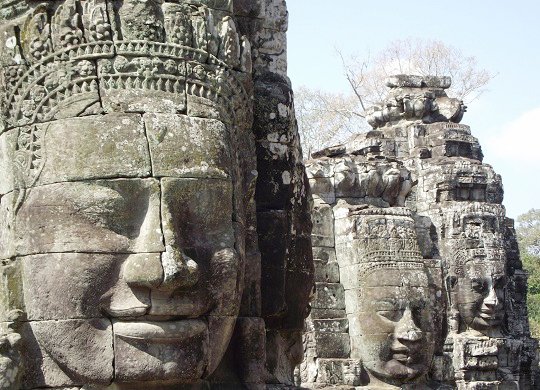
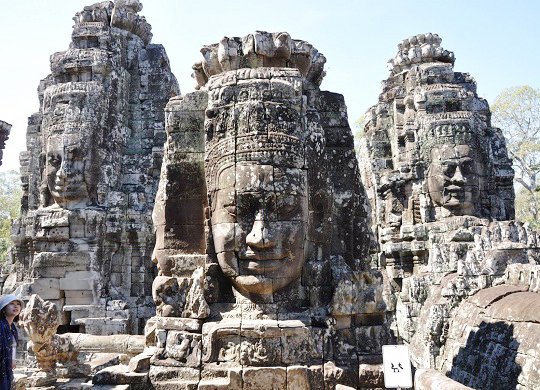
Avalokiteshvara is a bodhisattva or Buddha-to-be who listens to the prayers of people in need and has delayed his own enlightenment until he has helped all people in accomplishing nirvana. To help these people and hear every one of their prayers, he would require many eyes and ears, which may clarify the numerous faces. Others have contended that the face is that of Jayavarman VII himself. This is additionally realistic, since Jayavarman VII viewed himself as a devaraja, or god-king.
Summary
The Bayon is one of the more attractive temples. To keep away from the crowds, you might need to time your visit for dawn or sunset. The vast majority of the group runs to Angkor Wat at dawn and the hill Phnom Bakheng at sunset, enabling you to enjoy some solitude at the Bayon. The brilliant, inclined light at those times of the day make the faces even more mystical, as the enigmatic smile of one face will jump out past the shadow of another.
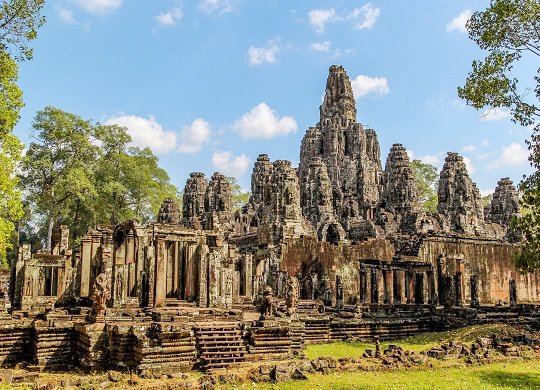
Some related articles:
- Cambodia Temple #12: Bakong Temple
- Cambodia Temple #11: Banteay Kdei Temple
- Cambodia Temple #10: Preah Palilay Temple
- Cambodia Temple #9: Chau Say Tevoda Temple
- Cambodia Temple #8: Baksei Chamkrong Temple
- Cambodia Temple #7: Preah Ko Temple
- Cambodia Temple #6: Neak Pean Temple
- Cambodia Temple #5: Takeo Temple
- Cambodia Temple #3: Banteay Chhmar Temple
- Cambodia Temple #2: Banteay Samre Temple
- Cambodia Temple #1: Banteay Srei Temple
I saw your post in my facebook group Seemit Community. I have decided to upvote it for its quality. Thanks for sharing! Very nice place.
Thanks for enjoying my article.
buen post, saludos, espero tu apoyo
Thanks
I just always accept that Bayon will be very crowded. That still doesn't detract from the amazement of the place. Bayon is usually a place I like to visit early and then work my way northwards on foot through the other temples. In the north east of Ankor Thom are some smaller temples that very few people think to visit. Those are good for a more relaxing time. I personally don't like to eat on holy sites, but if you don't share that sentiment, then that's where I'd be looking to have a quiet picnic.
Thanks
You make it look easy!